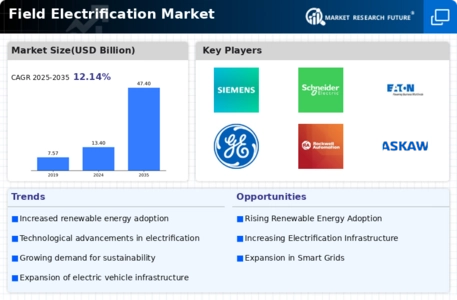Government Incentives and Support
Government policies and incentives play a crucial role in shaping the Field Electrification Market. Many governments are implementing favorable regulations and financial incentives to promote electrification as part of their energy transition strategies. For example, tax credits, grants, and subsidies for electric vehicles and infrastructure development are becoming increasingly common. This support is expected to drive market growth, with estimates suggesting a potential increase in market size by 15% over the next five years. Additionally, regulatory frameworks that mandate emissions reductions are pushing industries to adopt electrification solutions. As a result, the Field Electrification Market is likely to benefit from enhanced investment and innovation, fostering a more sustainable energy landscape.
Increased Focus on Energy Efficiency
The growing emphasis on energy efficiency is a significant driver of the Field Electrification Market. Industries are increasingly recognizing the economic and environmental benefits of adopting electrified solutions. Enhanced energy efficiency not only reduces operational costs but also minimizes energy waste, aligning with corporate sustainability goals. Reports indicate that electrification can lead to energy savings of up to 30% in certain applications. As organizations strive to improve their energy performance, the demand for electrified equipment and systems is expected to rise. This trend is likely to propel the Field Electrification Market forward, as companies seek to leverage electrification as a means to achieve both financial and environmental objectives.
Rising Demand for Sustainable Solutions
The increasing emphasis on sustainability is driving the Field Electrification Market. As industries and consumers alike seek to reduce their carbon footprints, electrification of field operations emerges as a viable solution. This shift is evidenced by a projected growth rate of approximately 8% annually in the electrification sector. Companies are investing in electric machinery and equipment to comply with environmental regulations and meet consumer expectations. The Field Electrification Market is thus witnessing a surge in demand for electric vehicles and machinery, which are perceived as cleaner alternatives to traditional fossil fuel-powered options. This trend not only aligns with global sustainability goals but also enhances operational efficiency, making electrification an attractive proposition for various sectors.
Growing Electrification of Transportation
The electrification of transportation is a pivotal driver for the Field Electrification Market. With the automotive sector undergoing a significant transformation, the demand for electric vehicles (EVs) is surging. This trend is supported by a projected increase in EV sales, which could reach 30% of total vehicle sales by 2030. The shift towards electric transportation not only reduces greenhouse gas emissions but also encourages the development of charging infrastructure, further stimulating the electrification market. As more companies and consumers adopt EVs, the Field Electrification Market is likely to expand, creating new opportunities for innovation and investment in related technologies. This transition is indicative of a broader movement towards sustainable transportation solutions.
Technological Innovations in Electrification
Technological advancements are significantly influencing the Field Electrification Market. Innovations in electric motors, power electronics, and control systems are enhancing the efficiency and reliability of electrified equipment. For instance, the development of smart grid technologies allows for better integration of renewable energy sources, optimizing energy consumption in field operations. The market is expected to see a compound annual growth rate of around 10% as these technologies become more prevalent. Furthermore, the introduction of advanced energy management systems enables real-time monitoring and control, which can lead to substantial cost savings. As these technologies evolve, they are likely to reshape the landscape of the Field Electrification Market, making electrification more accessible and efficient.


















Leave a Comment